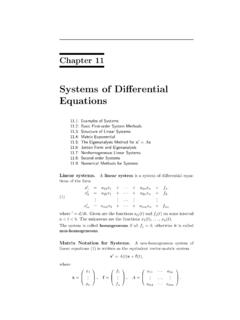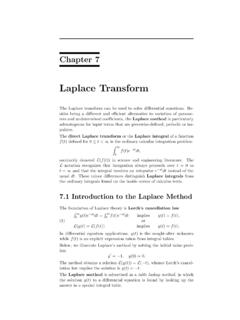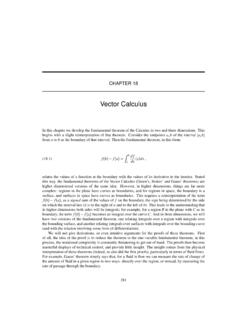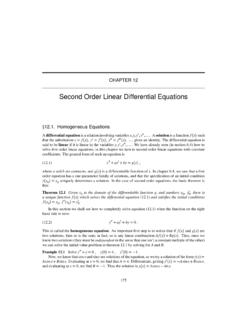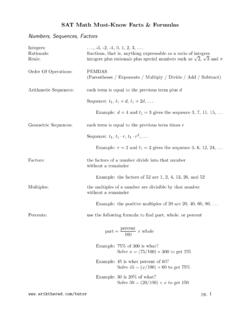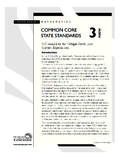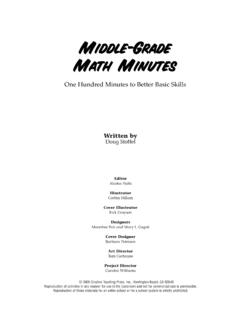Transcription of Factoring Polynomials - Math
1 Factoring PolynomialsAny natural number that is greater than 1 can be factored into a productof prime numbers. For example 20 = (2)(2)(5) and 30 = (2)(3)(5).In this chapter we ll learn an analogous way to factor Theorem of AlgebraAmonicpolynomial is a polynomial whose leading coe cient equals 1. Sox4 2x3+5x 7ismonic,andx 2ismonic,but3x2 following result tells us how to factor Polynomials . It essentially tellsus what the prime Polynomials are:Any polynomial is the product of a real number,and a collection of monic quadratic Polynomials thatdo not have roots, and of monic linear result is called theFundamental Theorem of Algebra. It is one ofthe most important results in all of mathematics, though from the formit s written in above, it s probably di cult to immediately understand explanation for why this theorem is true is somewhat di cult, and itis beyond the scope of this course.
2 We ll have to accept it on 4x2 12x+8canbefactoredintoaproductofanumber, 4,andtwo monic linear Polynomials ,x 1andx 2. That is,4x2 12x+8=4(x 1)(x 2).157 Factoring PolynomialsAny natural number that is greater than 1 can be factored into a productof prime numbers. For example 20 = (2)(2)(5) and 30 = (2)(3)(5).In this chapter we ll learn an analogous way to factor Theorem of AlgebraAmonicpolynomial is a polynomial whose leading coe cient equals 1. Sox4 2x3+5x 7ismonic,andx 2ismonic,but3x2 Friedrich Gauss was the boy who discovered a really quick way to seethat 1 + 2 + 3 + +100= 1799, a grown-up Gauss proved the following theorem:Any polynomial is the product of a real number,and a collection of monic quadratic Polynomials thatdo not have roots, and of monic linear result is called theFundamental Theorem of Algebra.
3 It is one ofthe most important results in all of mathematics, though from the formit s written in above, it s probably di cult to immediately understand explanation for why this theorem is true is somewhat di cult, and itis beyond the scope of this course. We ll have to accept it on 4x2 12x+8canbefactoredintoaproductofanumber, 4,andtwo monic linear Polynomials ,x 1andx 2. That is,4x2 12x+8=4(x 1)(x 2). (2)(2)(5)and30 (2)(3)(5).2030/\/\ \/\2235 Inthischapterwe 2x3+5x 7ismonic,andx 2ismonic,but3x2 +2+3+ +100= ,agrown-upGaussprovedthefollowingtheorem :Anypolynomialistheproductofarealnumber, andacollectionofmonicquadraticpolynomial sthatdonothaveroots, ,thoughfromtheformit swritteninabove,it , 4x2 12x+8canbefactoredintoaproductofanumber, 4,andtwomoniclinearpolynomials,x 1andx ,4~2_12x+8=4(x 1)(x 2).
4 130 x5+2x4 7x3+14x2 10x+20canbefactoredintoaproductof a number, 1, a monic linear polynomial,x 2, and two monicquadratic Polynomials that don t have roots,x2+2 andx2+5. Thatis x5+2x4 7x3+14x2 10x+20= (x 2)(x2+2)(x2+5).(We can check the discriminants ofx2+2andx2+5toseethatthese two quadratics don t have roots.) 2x4 2x3+14x2 6x+24=2(x2+3)(x2 x+ 4). Again,x2+3andx2 x+ that in each of the above examples, the real number that appearsin the product of Polynomials 4 in the first example, 1inthesecond,and 2 in the third is the same as the leading coe cient for the originalpolynomial. This always happens, so the Fundamental Theorem of Algebracan be more precisely stated as follows:Ifp(x)=anxn+an 1xn 1+ +a0,thenp(x)istheproductoftherealnumbera n,and a collection of monic quadratic Polynomials thatdo not have roots, and of monic linear it is written as a product of a realnumber (which will be the same number as the leading coe cient of thepolynomial), and a collection of monic quadratic Polynomials that do nothave roots, and of monic linear at the examples above, 4(x 1)(x 2) and (x 2)(x2+2)(x2+5)and 2(x2+3)(x2 x+4) reason it s nice to completely factor a polynomial is because if you do,then it s easy to read o what the roots of the polynomial (x)= 2x5+10x4+2x3 38x2+4x 48.
5 Writtenin this form, its di cult to see what the roots ofp(x)are. Butafterbeingcompletely factored,p(x)= 2(x+2)(x 3)(x 4)(x2+1). Therootsof158this polynomial can be read from the monic linear factors . They are 2, 3,and 4.(Notice thatp(x)= 2(x+2)(x 3)(x 4)(x2+1)iscompletelyfactoredbecausex2+1h asnoroots.)** Factoring linearsTo completely factor a linear polynomial, just factor out its leading coe -cient:ax+b=a x+ba For example, to completely factor 2x+6,writeitastheproduct2(x+3). Factoring quadraticsWhat a completely factored quadratic polynomial looks like will depend onhow many roots it the quadratic polynomialax2+bx+chas 0 roots, then it canbe completely factored by Factoring out the leading coe cient:ax2+bx+c=a x2+bax+ca (The graphs ofax2+bx+candx2+bax+cadi er by a vertical stretch or shrinkthat depends ona.)
6 A vertical stretch or shrink of a graph won t change thenumber ofx-intercepts, sox2+bax+cawon t have any roots sinceax2+bx+cdoesn t have any roots. Thus,x2+bax+cais completely factored.) discriminant of 4x2 2x+2 equals ( 2)2 4(4)(2) = 4 32 = 28, a negative number. Therefore, 4x2 2x+2hasnoroots, anditiscompletely factored as 4(x2 12x+12). the quadratic polynomialax2+bx+chas 2 roots, we canname them 1and 2. Roots give linear factors , so we know that (x 1)159and (x 2)arefactorsofax2+bx+c. That means that there is somepolynomialq(x)suchthatax2+bx+c=q(x)( x 1)(x 2)The degree ofax2+bx+cequals 2. Because the sum of the degrees of thefactors equals the degree of the product, we know that the degree ofq(x)plusthe degree of (x 1)plusthedegreeof(x 2) equals 2.
7 In other words,the degree ofq(x) is the only number that you can add to 1 + 1 to get 2, soq(x) musthave degree 0, which means thatq(x) the leading term ofax2+bx+c namelyax2 istheproductofthe leading terms ofq(x), (x 1), and (x 2) namelythenumberq(x),x,andx itmustbethatq(x)=a. Therefore,ax2+bx+c=a(x 1)(x 2) discriminant of 2x2+4x 2equals42 4(2)( 2) = 16+16 =32, a positive number, so there are two can use the quadratic formula to find the two roots, but before we do,it s best to simplify the square root of the discriminant:p32 =p(4)(4)(2) = we use the quadratic formula to find that the roots are 4+4p22(2)= 4+4p24= 1+p2and 4 4p22(2)= 4 4p24= 1 p2 Therefore, 2x2+4x 2iscompletelyfactoredas2 x ( 1+p2) x ( 1 p2) =2(x+1 p2)(x+1+p2) +bx+chas exactly 1 root (let s call it 1)then(x 1)isafactorofax2+bx+c.
8 Hence,ax2+bx+c=g(x)(x 1)for some polynomialg(x).160 Because the degree of a product is the sum of the degrees of the factors ,g(x)mustbeadegree1polynomial,and itcanbecompletelyfactoredintosomething of the form (x )where , 2R. Therefore,ax2+bx+c= (x )(x 1)Notice that is a root of (x )(x 1), so is a root ofax2+bx+csince they are the same polynomial. But we know thatax2+bx+chas onlyone root, namely 1, so must equal 1. That means thatax2+bx+c= (x 1)(x 1)The leading term ofax2+bx+cisax2. The leading term of (x 1)(x 1)is x2. Sinceax2+bx+cequals (x 1)(x 1), they must have the sameleading term. Therefore,ax2= x2. Hence,a= .Replace withain the equation above, and we are left withax2+bx+c=a(x 1)(x 1) discriminant of 3x2 6x+3 equals ( 6)2 4(3)(3) = 36 36 =0, so there is exactly one root.
9 We find the root using the quadratic formula: ( 6) +p02(3)=66=1 Therefore, 3x2 6x+3iscompletelyfactoredas3(x 1)(x 1). following chart summarizes the discussion ofax2+bx+ccompletely factored form ofax2+bx+cno rootsa(x2+bax+ca)2roots: 1and 2a(x 1)(x 2)1root: 1a(x 1)(x 1)161** factors inZRecall that the factors of an integernare all of the integersksuch thatn=mkfor some third 12 = 3 4, so 4 is a factor of 12. 30 = 2 15, so 15 is a factor of 30. 1, 1,nand nare all factors of an integern. That s becausen=n 1andn=( n)( 1).Important special 1, 2,.. n2Z, then each of these numbersare factors of the product 1 2 n. For example, 2, 10, and 7 are eachfactors of 2 10 7= factors of degree 0 coe cient when searching forrootsIfk, 1,and 2are all integers, then the polynomialq(x)=k(x 1)(x 2)=kx2 k( 1+ 2)x+k 1 2has 1and 2as roots, and each of these roots are factors of the degree 0coe cient ofq(x).
10 (The degree 0 coe cient isk 1 2.)More generally, ifk, 1, 2,.., n2Z, then the degree 0 coe cient of thepolynomialg(x)=k(x 1)(x 2) (x n)equalsk 1 2 n. That means that each of the roots ofg(x) whicharethe i arefactorsofthedegree0coe cient ofg(x).Now it s not true that every polynomial has integer roots, but many of thepolynomials you will come across do, so the two paragraphs above o er apowerful hint as to what the roots of a polynomial might searching for roots of a polynomialwhose coe cients are all integers,check the factors of the degree 0 coe 7arebothrootsof2(x 3)(x+7).Notice that 2(x 3)(x+7)=2x2+8x 42, and that 3 and 7arebothfactors of (x)=3x4+3x3 3x2+3x 6. This is a degree 4polynomial, so it will have at most 4 roots.


